Sleep beside the highest tides in the world, and drive on the ocean floor to an island in one of Atlantic Canada’s most underrated provinces, New Brunswick.
While Prince Edward Island (PEI) and Nova Scotia are more popular destinations for overlanders, New Brunswick offers some unique experiences. As a New Brunswicker from the northeast region, it is here that I got my first taste for vehicle-supported adventure travel. However, I wasn’t at the wheel of a 4WD vehicle; I had an ATV. Driving at full throttle on a dirt road by the Baie des Chaleurs and kicking up clouds of dust behind me gave me such a sense of freedom. In fact, it’s those souvenirs that got me behind the wheel of my first 4WD vehicle about 10 years ago.
As overlanding enthusiasts, we often dream about exploring far away on what we’d consider the ultimate overland trip. But have we fully explored our own backyard? It’s for this reason that I booked three weeks last fall to head to southern New Brunswick, a region that I had yet to explore. What I found is a much different landscape compared to the north, and a culture shaped by the sea, or more precisely, by the Bay of Fundy. During this trip, I would sleep close and personal with the highest tides in the world, drive on the ocean floor to an island, and push my brand-new Jeep to its limit on one of New Brunswick’s most difficult off-road trails.



Hopewell Rocks
Even if you’re just driving through to get to PEI or Nova Scotia, stopping by to visit the Hopewell Rocks is a must. The Hopewell Rocks were created millions of years ago and were originally part of a massive mountain range—they are older than the Appalachians and bigger than the Canadian Rockies. The rocks continue to erode today, thanks to the winds and the tides that can reach up to 14 meters (46 feet) in the area, as high as a four-story building.
If you can, visit the area at both high tide and low tide to get a different perspective. I only visited at low tide, but as an advantage, I was able to walk on the ocean floor around the rock formations. There are also some outfitters in the area that can take you on a kayak trip to explore around the formations at high tide.
Fundy National Park
While you might have a preference for off-grid camping when on an overland trip, Fundy National Park is worth a stop. It’s a popular destination in the southern region, but when I visited in September, I almost had it to myself. With over 100 kilometers (62 miles) of hiking trails, you will have plenty of choices. I hiked the Matthew’s Head Trail, and I’m not about to forget the view from the shore. Rated as moderate in terms of difficulty, Matthew’s Head’s 4.5-kilometer (2.8-mile) loop takes about two hours to complete. I would also recommend that you hike the Dickson Falls.
Loop Trail. Rated as easy, it’s only 1.5 kilometers (1 mile) long and will get you to one of the park’s most-photographed waterfalls.
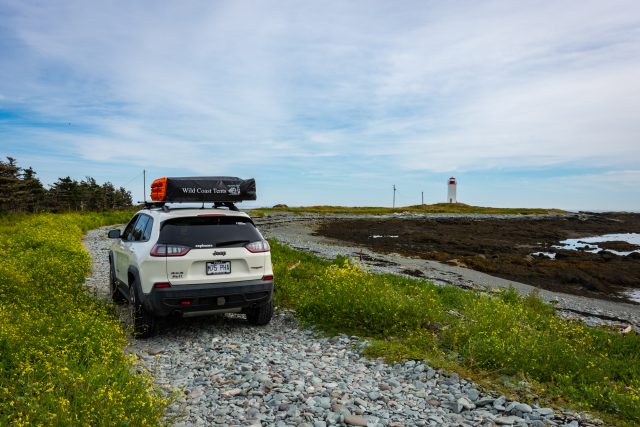
Fundy Trail Parkway
While I’ve yet to drive Cape Breton Island’s Cabot Trail, the Fundy Trail Parkway is similar. It starts in the area of Saint Martins and takes you along the Fundy’s bay coast on a 30-kilometer (19-mile) roundtrip. Make sure to stop occasionally to take in the view at some of the 21 lookouts. The parkway also has many scenic hiking trails to choose from. Note that the Fundy Trail Parkway is finally scheduled to connect with Alma just beside Fundy National Park for the 2021 season.
Ministers Island
There are not many places on Earth where you can drive on the ocean floor to an island. Ministers Island, near Saint Andrews, is a “part-time” island and allows you to do just that. Once on the island, you can visit the summer estate of Sir William Van Horne, a builder of the Canadian Pacific Railway. The island is accessible by driving or walking over the ocean floor about 1 kilometer (0.6 miles) at low tide. At high tide, the bar that connects the island to the mainland is under about 4.3 meters (14 feet) of water.
Grand Manan Island
From an overlanding perspective, I found that not much was being said about Grand Manan Island when doing my pre-trip research. So, I decided to explore it and see what it had to offer. A one and a half hour ferry ride from Black Harbour got me there. I boarded the ferry on a clear day, and as I got closer to the island, I could appreciate its rugged cliffs on the northeast side and then had a sighting of the island’s iconic lighthouse: the Swallowtail.
Grand Manan is the biggest island of Fundy’s isles. It’s not too touristy, so it’s the place to go for some peace and quiet. But if you want to get to a place even more remote, a free 20-minute ferry from the island will get you to White Head Island. White Head is a smaller island with only about 180 residents. While there’s no camping accommodation, it’s still worth a visit just for its remoteness.
Don’t expect to find many trails to explore on Grand Manan, though; most trails are more suitable to ATVs.
Cape Spencer
The Cape Spencer trail is for the most adventurous overlanders. The trail is a bit overgrown and ideal for smaller 4WD vehicles. Let’s say I wouldn’t attempt this trail with a full-size truck. Since there was no way I was going to try this trail on my own with my brand-new Jeep, I asked Virgil and Nick from Northbound Expeditions if they’d be willing to guide me. With their help, I managed to navigate the trail without damaging my Jeep. However, I can tell you that all of my skid plates and rock sliders were put to good use. It’s on that trail that I learned about the capability of my Jeep and how to trust its traction management system.
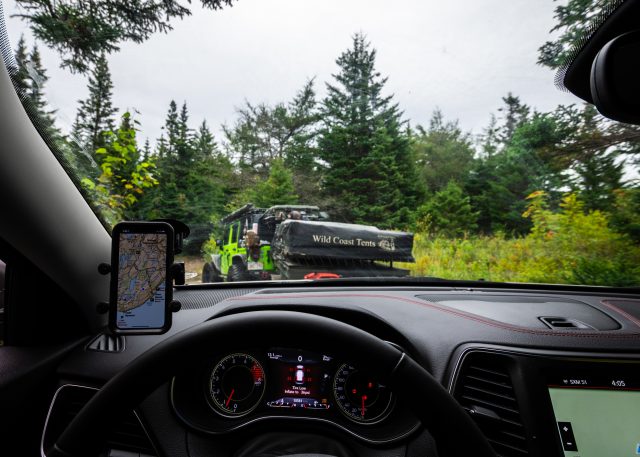
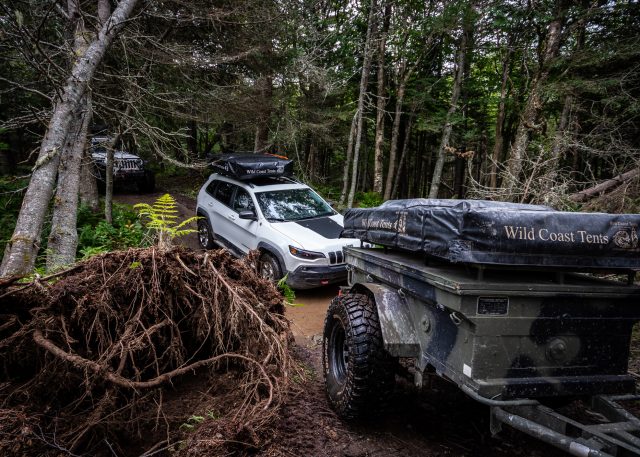
Martin Head
Martin Head is located just about 10 kilometers (6.2 miles) west of Fundy National Park. It’s a popular camping destination for the locals and is situated on Crown land (free camping). It’s accessible through a network of secondary roads, snowmobile, and ATV trails. At that location, you are close and personal with the highest tides in the world, so make sure to set up camp high enough on the beach.
Other Off-grid Locations
There are many areas where you can camp for free on Crown land. I found that Backroad Mapbook and iOverlander were great resources to find these off-grid campsites. And if you’re willing to go a bit more north, just pull out a map of New Brunswick and look at the central part—there are basically no roads, only logging roads waiting to be explored. New Brunswick is definitely underrated as an overland destination, and people are missing out by just driving through.

Trip Planning Information
For the must-see places in the area, get your free travel guide: https://www.tourismnewbrunswick.ca
Navigation
Get yourself a Backroad Mapbook (hard copy and digital formats available) covering New Brunswick and PEI.
https://www.backroadmapbooks.com
Overland Tours and Event Organizer
North Bound Expeditions Inc.
Where to Stay
Provincial Parks
There are a total of nine provincial parks in New Brunswick. I recommend that you stay at the Anchorage provincial park while on Grand Manan Island.
https://parcsnbparks.ca/Home.aspx


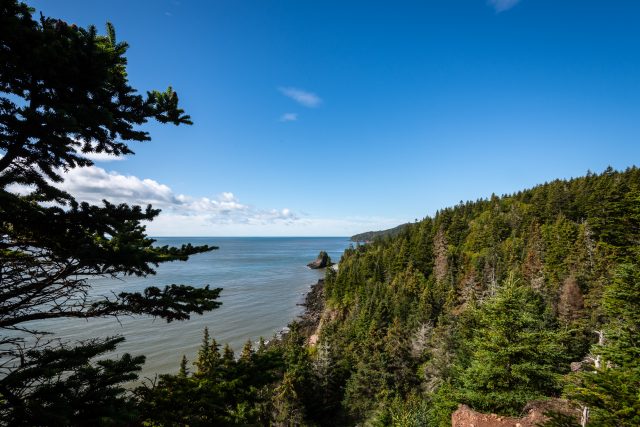
National Parks
There are two national parks in New Brunswick: Kouchibouguac and Fundy. If you want to try something a little different, stay in one of their oTENTiks, yurts, or one of the new Ôasis structures for a few nights.
Local Park
Stay at the North Head Campground and Park on Grand Manan Island. This local campground is the perfect basecamp to explore the area. Make sure to hike the short Hole in the Wall Trail to visit the island’s famous rock arch.
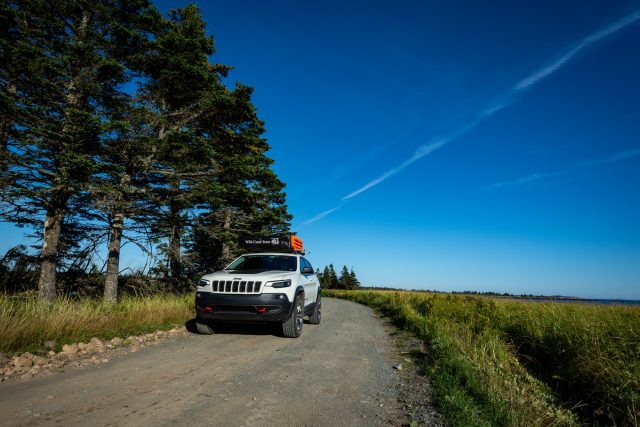
Meet the Jeep
2019 Jeep Cherokee Trailhawk (V6 3.2L), lightly modified for overlanding.
Favorite Modifications: MFC Offroad two-inch lift kit. www.mfcoffroad.com
245/70/17 Cooper Discoverer AT3 4S: http://us.coopertire.com
MOPAR rock rails: https://www.jeep.ca/en




